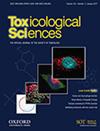An environmentally relevant mixture of Perfluoroalkyl Substances (PFAS) impacts proliferation, steroid hormone synthesis, and gene transcription in primary human granulosa cells
IF 3.4
3区 医学
Q2 TOXICOLOGY
引用次数: 0
Abstract
Perfluoroalkyl substances (PFAS) are a group of synthetic chemicals that are resistant to biodegradation and are environmentally persistent. PFAS are found in many consumer products and are a major source of water and soil contamination. This study investigated the effects of an environmentally relevant PFAS mixture [perfluorooctanoic acid (PFOA), perfluorooctanesulfonic acid (PFOS), perfluorohexanesulfonic acid (PFHxS)] on the transcriptome and function of human granulosa cells (hGCs). Primary hGCs were harvested from follicular aspirates of healthy, reproductive-age women who were undergoing oocyte retrieval for in vitro fertilization. LC/MS-MS was performed to identify PFAS compounds in pure follicular fluid. Cells were cultured with vehicle control or a PFAS mixture (2 nM PFHxS, 7 nM PFOA, 10 nM PFOS) for 96h. Analyses of cell proliferation/apoptosis, steroidogenesis, and gene expression were measured via MTT assays/immunofluorescence, ELISA/western blotting, and RNA sequencing/bioinformatics, respectively. PFOA, PFOS, and PFHxS were detected in 100% of follicle fluid samples. Increased cell proliferation was observed in hGCs treated with the PFAS mixture with no impacts on cellular apoptosis. The PFAS mixture also altered steroid hormone synthesis, increasing both FSH-stimulated and basal progesterone secretion and concomitant upregulation of STAR protein. RNA sequencing revealed inherent differences in transcriptomic profiles in hGCs after PFAS exposure. This study demonstrates functional and transcriptomic changes in hGCs after exposure to a PFAS mixture, improving our knowledge about the impacts of PFAS exposures and female reproductive health. These findings suggest that PFAS compounds can disrupt normal granulosa cell function with possible long-term consequences on overall reproductive health.与环境相关的全氟烷基物质(PFAS)混合物影响原代人类颗粒细胞的增殖、类固醇激素合成和基因转录
全氟烷基物质(PFAS)是一组耐生物降解且具有环境持久性的合成化学品。PFAS 存在于许多消费品中,是水和土壤污染的主要来源。本研究调查了与环境相关的 PFAS 混合物[全氟辛酸(PFOA)、全氟辛烷磺酸(PFOS)、全氟己烷磺酸(PFHxS)]对人类颗粒细胞(hGCs)转录组和功能的影响。原代 hGCs 取自健康育龄女性的卵泡抽吸物,这些女性正在为体外受精进行卵母细胞提取。采用 LC/MS-MS 方法鉴定纯卵泡液中的 PFAS 化合物。用车辆对照或 PFAS 混合物(2 nM PFHxS、7 nM PFOA、10 nM PFOS)培养细胞 96 小时。细胞增殖/凋亡、类固醇生成和基因表达的分析分别通过 MTT 检测/免疫荧光、ELISA/免疫印迹和 RNA 测序/生物信息学进行测量。100%的卵泡液样本中都检测到了 PFOA、PFOS 和 PFHxS。在使用 PFAS 混合物处理的 hGCs 中观察到细胞增殖增加,但对细胞凋亡没有影响。PFAS 混合物还改变了类固醇激素的合成,增加了 FSH 激素和基础孕酮的分泌,并同时上调了 STAR 蛋白。RNA 测序揭示了暴露于 PFAS 后 hGCs 转录组的内在差异。这项研究表明,暴露于 PFAS 混合物后,hGCs 的功能和转录组发生了变化,从而增进了我们对 PFAS 暴露和女性生殖健康影响的了解。这些研究结果表明,PFAS化合物会破坏颗粒细胞的正常功能,并可能对整体生殖健康产生长期影响。
本文章由计算机程序翻译,如有差异,请以英文原文为准。
求助全文
约1分钟内获得全文
求助全文
来源期刊

Toxicological Sciences
医学-毒理学
CiteScore
7.70
自引率
7.90%
发文量
118
审稿时长
1.5 months
期刊介绍:
The mission of Toxicological Sciences, the official journal of the Society of Toxicology, is to publish a broad spectrum of impactful research in the field of toxicology.
The primary focus of Toxicological Sciences is on original research articles. The journal also provides expert insight via contemporary and systematic reviews, as well as forum articles and editorial content that addresses important topics in the field.
The scope of Toxicological Sciences is focused on a broad spectrum of impactful toxicological research that will advance the multidisciplinary field of toxicology ranging from basic research to model development and application, and decision making. Submissions will include diverse technologies and approaches including, but not limited to: bioinformatics and computational biology, biochemistry, exposure science, histopathology, mass spectrometry, molecular biology, population-based sciences, tissue and cell-based systems, and whole-animal studies. Integrative approaches that combine realistic exposure scenarios with impactful analyses that move the field forward are encouraged.
 求助内容:
求助内容: 应助结果提醒方式:
应助结果提醒方式:


